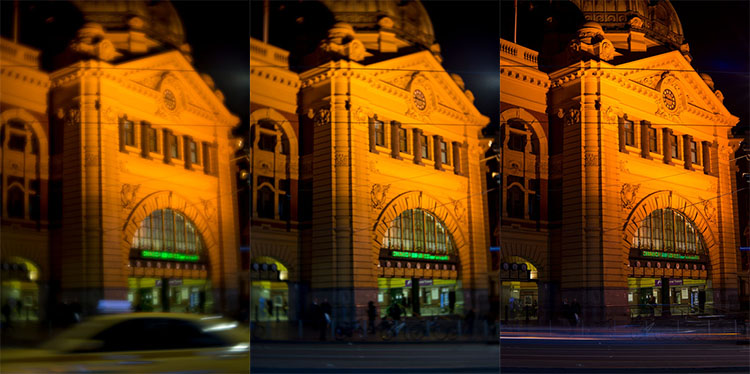$ (document).ready(function() { SampleGalleryV2({“containerId”:”embeddedSampleGallery_2279443352″,”galleryId”:”2279443352″,”isEmbeddedWidget”:true,”selectedImageIndex”:0,”isMobile”:false}) });
Lensbaby’s newest offering, the Burnside 35, is a 35mm Petzval-inspired lens that features the swirly bokeh of the company’s Twist 60 in a wider angle 35mm lens plus additional creative control through a vignetting slider. As with the Twist 60, the amount of swirl is controlled by the aperture: maximum swirl at F2.8, with each subsequent stop down removing swirl and increasing the central area of sharp focus.
The additional “effect slider” on the barrel of the lens gives you another way to control swirl and bokeh – although the effect of the slider on those elements seems to be somewhat minimal compared to using the aperture – and adds up to four levels of vignetting to your images. Per Lensbaby’s description of the Burnside 35, it’s meant to be a versatile creative lens for street photography, landscapes, and environmental portraits.
 |
I should give a quick disclosure here: I have been known to say that I don’t like shooting at 35mm. As a photographer who focuses on lifestyle, events and portraiture, I prefer wider (24mm to 28mm) for contextual scenes and longer (135mm and up) for portraits. 35mm always feels a little too ‘in between’ and the framing is never quite right for me. I can normally accommodate this preference of mine by cropping in post, but cropping images taken with a creative lens removes some of the intended effects. Using a new creative lens always requires a bit of a learning curve, and this one also required that I revisit shooting with a 35mm eye. I had varying levels of success with each of those challenges.
 |
What I liked:
- The bokeh, especially shooting open at F2.8 or F4. As long as I didn’t choose a background that was too busy, the swirly bokeh was pleasingly subtle and smooth. It gave the effect of a bit more subject isolation than I typically get when shooting a portrait at 35mm, which helped me overcome my wish for a longer lens.
- The colors, straight out of camera. This is something that I like about most Lensbaby lenses and optics. There is a depth and contrast in the colors that means I have to do very little post-processing of the Raw images (although I did find the blues and greens to be a touch more saturated than I’d choose myself).
- The vignetting effect. I don’t normally use a lot of vignetting in my editing so I wasn’t sure what I’d do with it here. And admittedly, this is what most of us questioned (or chuckled about) – is it just a built-in Instagram filter? It turns out that no, it’s not just an Instagram filter. Like most effects that Lensbaby offers, the vignetting in the Burnside 35 is a bit more clever than a simple vignette. Increasing the vignette darkens the edges, but it also deepens and amplifies the swirl in the bokeh. This means that you can use a smaller aperture to get more of your subject in focus and then dial up the swirl with the vignette, provided you don’t need the edges of your frame to be bright.
 |
What I struggled with:
- Centering my composition. The Burnside 35 is built for a bright central area of sharp focus, with the swirl and vignetting effects happening around the edges. This is similar to the Twist 60, but with the 60mm focal length of the Twist, I shoot more classic portraits and don’t mind centering my subject as much. When shooting wider, I tend to compose my shots with my subjects off-center, which was my instinct with the Burnside 35. But then I was not able to get my subject into focus and I was forced to reframe.
- Balancing the swirl and vignette. I think this will come with practice, but in the time that I’ve been shooting with the Burnside 35 I have not found my sweet spot of swirl vs vignette. I had to do a lot of chimping to get the shot I wanted, which meant that I missed many of the street and documentary shots I was after. Normally this doesn’t bother me because I know there’s a learning curve for any creative lens, but since the 35mm focal length lends itself to more street and documentary style shooting, it was harder for me to set myself up for the success I could get with a more controlled environment.
- Focus. This is actually an extension of my previous point. My hit rate for focus was remarkably low with the Burnside 35, and it was due mostly to user error. However, as someone who is quite comfortable with manual focus, I know that my errors were helped along by the same things I mentioned above: the wider angle lending itself to a certain way of shooting plus the focus area requiring more precision in the center of the frame. These are both errors I could have reduced by making better choices, so I’ll chalk most of this up to me.
 |
Overall, I think the Burnside 35 is a versatile lens for a street or environment portrait photographer looking to expand their creative options. Yes, many of the effects can be approximated with software or by applying this material or that to a filter screwed onto a 35mm prime. But to me, the value of a creative lens is to enable, coax, and sometimes force myself to see and shoot familiar subjects differently, and to do it with consistent, repeatable results. Only then does it move from being a fun toy to becoming a part of my creative toolkit, and I can see the Burnside 35 fitting into my workflow quite nicely. Once I get a bit more proficient with the focus, of course.
Check out our Lensbaby Burnside 35
real-world sample gallery
Articles: Digital Photography Review (dpreview.com)











































You must be logged in to post a comment.